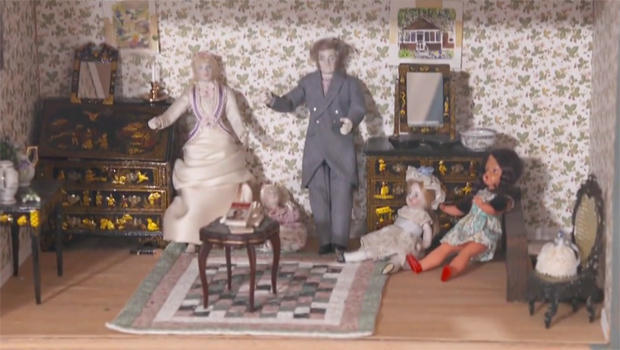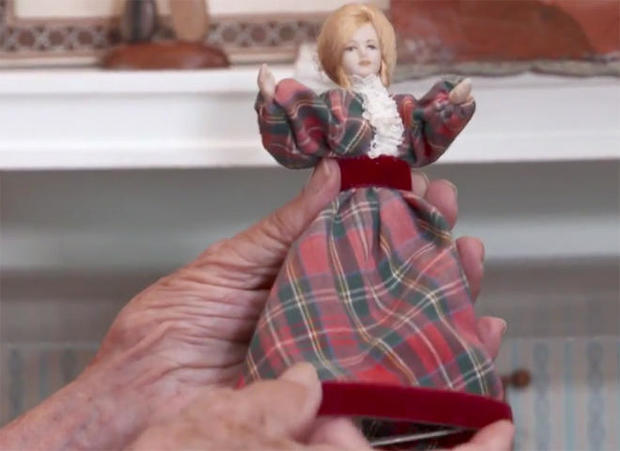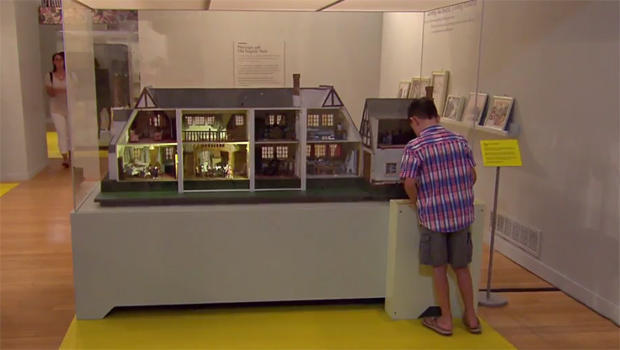Dollhouses as history, and therapy
Is a doll house simply a small world, a plaything to be outgrown over time? Not for the woman Chip Reid is taking us to visit:
“Every day a little bit, I play,” said Dr. Ruth Westheimer.
“What do you do?” asked Reid.
“I just move them around.”
You might be surprised to learn that at 88 years old, well-known sex therapist Dr. Ruth Westheimer still plays with dollhouses.
She started collecting them long before the days when she was giving blunt advice on a topic many considered taboo.
In this house, there are miniature versions of some of her books on sex. But don’t get any ideas
“Now, there’s no sex in these dollhouses, is there?” Reid asked.
“They don’t do it. They don’t have sex. No, I don’t want them to have sex!” she laughed. “I will have sex myself! Or I’ve had sex. I have never had the dollhouses having sex.”
In fact, her obsession with dolls is not just innocent; it’s heart-breaking. It started when she was 10 years old in Germany, when the Nazis came knocking.
“They came in with shiny black boots, very scary. They didn’t shout. They just told my father to get dressed, to go with them. My grandmother, in the seam of her long skirt, she had some money. I can see it in front of my eyes right now when I talk to you. She took the money out. She gave it to the Nazi. And she said, ‘Take good care of my son.’”
One doll’s dress, then, makes her think of the Nazis taking her father away. “Absolutely.”
Her desperate mother put Ruth on a train to Switzerland to escape the Holocaust. She grew up in an orphanage and never saw, or heard from, her parents again.
“Another girl on the train was crying,” she recalled. “She was younger than me. I had one doll with me. They only permitted me one doll. I gave that doll to that girl. And that’s all I had, because she was crying. She needed the doll more than me.”
And so began her fascination with dolls and dollhouses.
“If I have to choose one reason why I have them, is that they’re all happy in their surroundings,” she said.
“So inside these dollhouses is a kind of safety and stability that you did not have as a child?”
“That’s right.”
She’s not just captivated by her own collection. Recently, Dr. Ruth visited “Small Stories,” an exhibit at the National Building Museum in Washington, on loan from London. It features 300 years of dollhouses.
“They become symbols of your own identity and of your relationships with others,” said curator Alice Sage.
Each one is a window into history.
Three centuries ago, they were status symbols for the wealthy.
“If we look at the Joy Wardrobe, which is in fact not a doll’s house but a wardrobe, you can see the influence of 17th century Dutch architecture very clearly on the facade, with big scrolls and beautiful stained-glass windows,” said Sage.
A dollhouse from 1890 shows the evolution of technology; it has a telephone, and a bath with hot running water -- exotic novelties at the time.
Others tell much darker stories. One evokes a young girl’s fear as she prepares for an air raid during World War II, with gas masks in a box on the floor.
“She had a very hard time when she was evacuated, and it was a way for her to work through those memories of the war,” said Sage.
“This was therapy for her?” Reid asked.
“Absolutely.”
But while many of these miniature architectural wonders focus on bygone eras, the museum commissioned modern designers to let their futuristic imaginations run wild
Wendy Evans Joseph titled her dollhouse “An Ordinary Evening,” with nightmarish monsters surrounding a child’s bedroom. “It is a bit of a scary dream house; it is a bit of a nightmare house!” Joseph laughed.
From beautiful, to therapeutic, to frivolous fun, dollhouses appeal to the voyeur in all of us.
“That one thing in my life that, that even at the age of 88 I can say that has to be constant, that nobody can touch,” said Westheimer. “They’re just mine. Not for my grandchildren. You can look at them. But you can’t take them with you!”
For more info:
- “Small Stories: At Home in a Dollhouse” at the National Building Museum, Washington, D.C. (through January 22)
- drruth.com
- studiojoseph.com (Wendy Evans Joseph)









